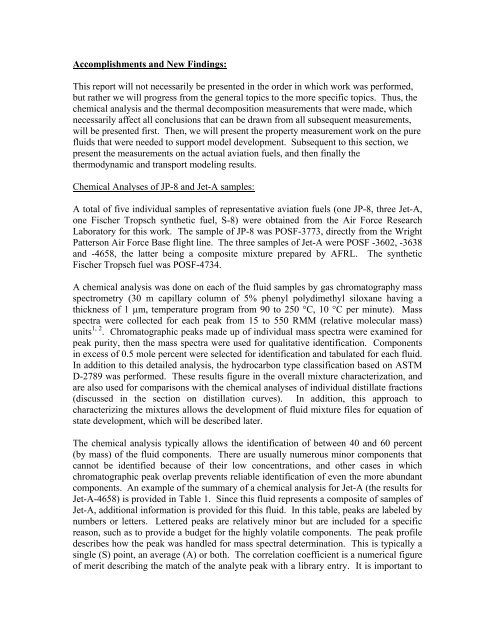Thermodynamic, Transport, and Chemical Properties of âReference ...
Thermodynamic, Transport, and Chemical Properties of âReference ...
Thermodynamic, Transport, and Chemical Properties of âReference ...
You also want an ePaper? Increase the reach of your titles
YUMPU automatically turns print PDFs into web optimized ePapers that Google loves.
Accomplishments <strong>and</strong> New Findings:This report will not necessarily be presented in the order in which work was performed,but rather we will progress from the general topics to the more specific topics. Thus, thechemical analysis <strong>and</strong> the thermal decomposition measurements that were made, whichnecessarily affect all conclusions that can be drawn from all subsequent measurements,will be presented first. Then, we will present the property measurement work on the purefluids that were needed to support model development. Subsequent to this section, wepresent the measurements on the actual aviation fuels, <strong>and</strong> then finally thethermodynamic <strong>and</strong> transport modeling results.<strong>Chemical</strong> Analyses <strong>of</strong> JP-8 <strong>and</strong> Jet-A samples:A total <strong>of</strong> five individual samples <strong>of</strong> representative aviation fuels (one JP-8, three Jet-A,one Fischer Tropsch synthetic fuel, S-8) were obtained from the Air Force ResearchLaboratory for this work. The sample <strong>of</strong> JP-8 was POSF-3773, directly from the WrightPatterson Air Force Base flight line. The three samples <strong>of</strong> Jet-A were POSF -3602, -3638<strong>and</strong> -4658, the latter being a composite mixture prepared by AFRL. The syntheticFischer Tropsch fuel was POSF-4734.A chemical analysis was done on each <strong>of</strong> the fluid samples by gas chromatography massspectrometry (30 m capillary column <strong>of</strong> 5% phenyl polydimethyl siloxane having athickness <strong>of</strong> 1 µm, temperature program from 90 to 250 °C, 10 °C per minute). Massspectra were collected for each peak from 15 to 550 RMM (relative molecular mass)units 1, 2 . Chromatographic peaks made up <strong>of</strong> individual mass spectra were examined forpeak purity, then the mass spectra were used for qualitative identification. Componentsin excess <strong>of</strong> 0.5 mole percent were selected for identification <strong>and</strong> tabulated for each fluid.In addition to this detailed analysis, the hydrocarbon type classification based on ASTMD-2789 was performed. These results figure in the overall mixture characterization, <strong>and</strong>are also used for comparisons with the chemical analyses <strong>of</strong> individual distillate fractions(discussed in the section on distillation curves). In addition, this approach tocharacterizing the mixtures allows the development <strong>of</strong> fluid mixture files for equation <strong>of</strong>state development, which will be described later.The chemical analysis typically allows the identification <strong>of</strong> between 40 <strong>and</strong> 60 percent(by mass) <strong>of</strong> the fluid components. There are usually numerous minor components thatcannot be identified because <strong>of</strong> their low concentrations, <strong>and</strong> other cases in whichchromatographic peak overlap prevents reliable identification <strong>of</strong> even the more abundantcomponents. An example <strong>of</strong> the summary <strong>of</strong> a chemical analysis for Jet-A (the results forJet-A-4658) is provided in Table 1. Since this fluid represents a composite <strong>of</strong> samples <strong>of</strong>Jet-A, additional information is provided for this fluid. In this table, peaks are labeled bynumbers or letters. Lettered peaks are relatively minor but are included for a specificreason, such as to provide a budget for the highly volatile components. The peak pr<strong>of</strong>iledescribes how the peak was h<strong>and</strong>led for mass spectral determination. This is typically asingle (S) point, an average (A) or both. The correlation coefficient is a numerical figure<strong>of</strong> merit describing the match <strong>of</strong> the analyte peak with a library entry. It is important to
















